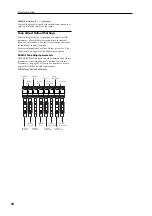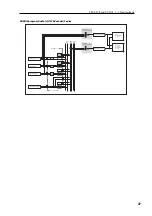
Operation
12
Modulation Sequencers
The Modulation Sequencers let you apply time-varying
change to sound parameters in a way similar to analog
sequencers of the past. A modulation sequencer stores a
discreet value for each of sixteen individual steps, and
consecutively applies these values to vary the sound over
time. Since three modulation sequencers are provided for
each program, you can create sounds that change in very
complex ways.
Make these settings in the PROG P5-6: MOD SEQ1, P5-7:
MOD SEQ2, and P5-8: MOD SEQ3 pages.
Here we’ll explain how to use modulation sequencer 1 to
modulate the oscillator pitch.
SEQ Common
Before we specify each step of the actual sequence data
itself, we’ll need to specify the number of steps in the
sequence, and the playback method. These parameters are
common to all three modulation sequencers.
1. Access the PROG P5-6: MOD SEQ1 page.
2. Turn on “MOD SEQ” On (checked).
If this is
On (checked)
, the three modulation sequencers will
be on, and the values stored in each step of each modulation
sequencer will modulate the sound parameters.
3. Set “LastStep” to 16.
The sequence will begin playing when a note-on occurs, and
will proceed for sixteen steps.
4. Set “Sequence Type” to Alt1.
5. Set “Run Mode” to Loop.
6. Set “KeySync” to 1st Note.
7. Set “Resolution” to
.
The sequencer will advance one step for each note value you
specify here, relative to the tempo. If this is set to
, the
sequencer will advance one step for each quarter-note beat.
Editing the steps
1. Set “Destination Param” to Pitch.
2. Use “Motion” to specify how the values stored in each
step will change when the modulation sequencer plays.
For this example, choose Smooth.
3. While playing the keyboard so that you can hear the
sound, specify the sequence data for each step. If you
want to adjust the value in detail, use the VALUE dial
etc.
The value of each step is applied as an amount of relative
change to the parameter’s assigned value.
Summary of Contents for EXB-RADIAS
Page 1: ...1 E ...
Page 76: ...68 ...















































